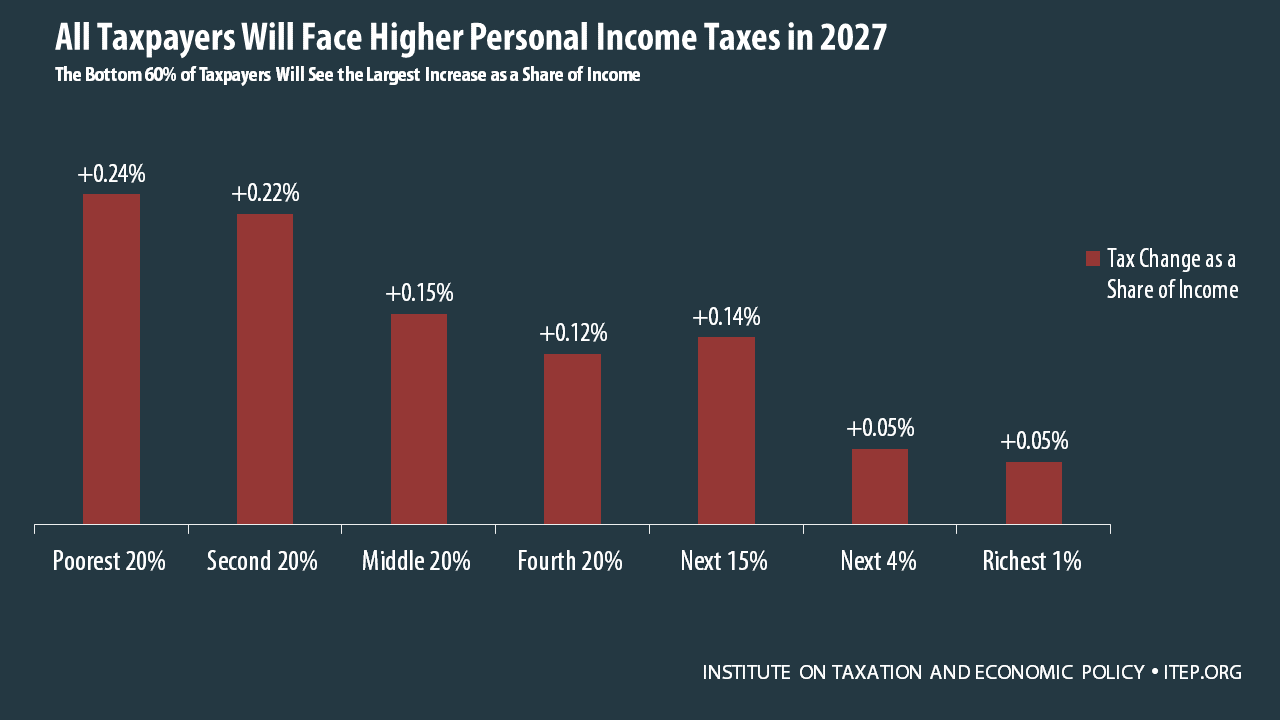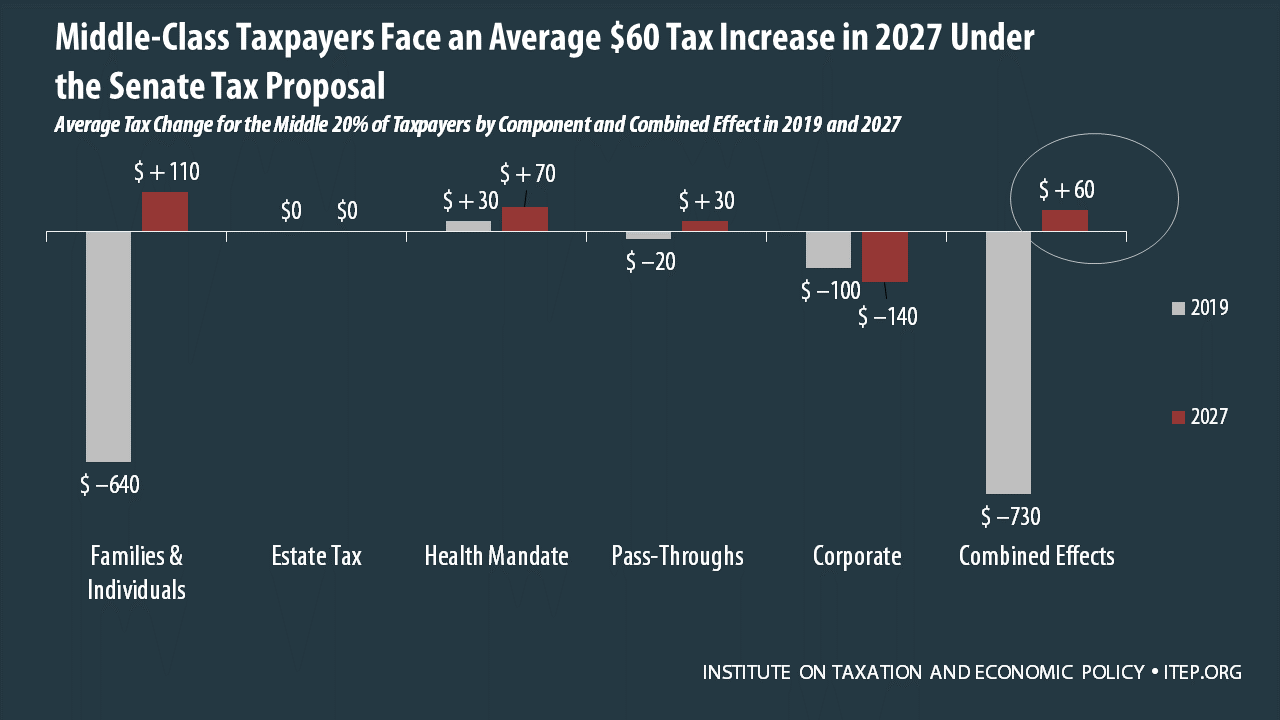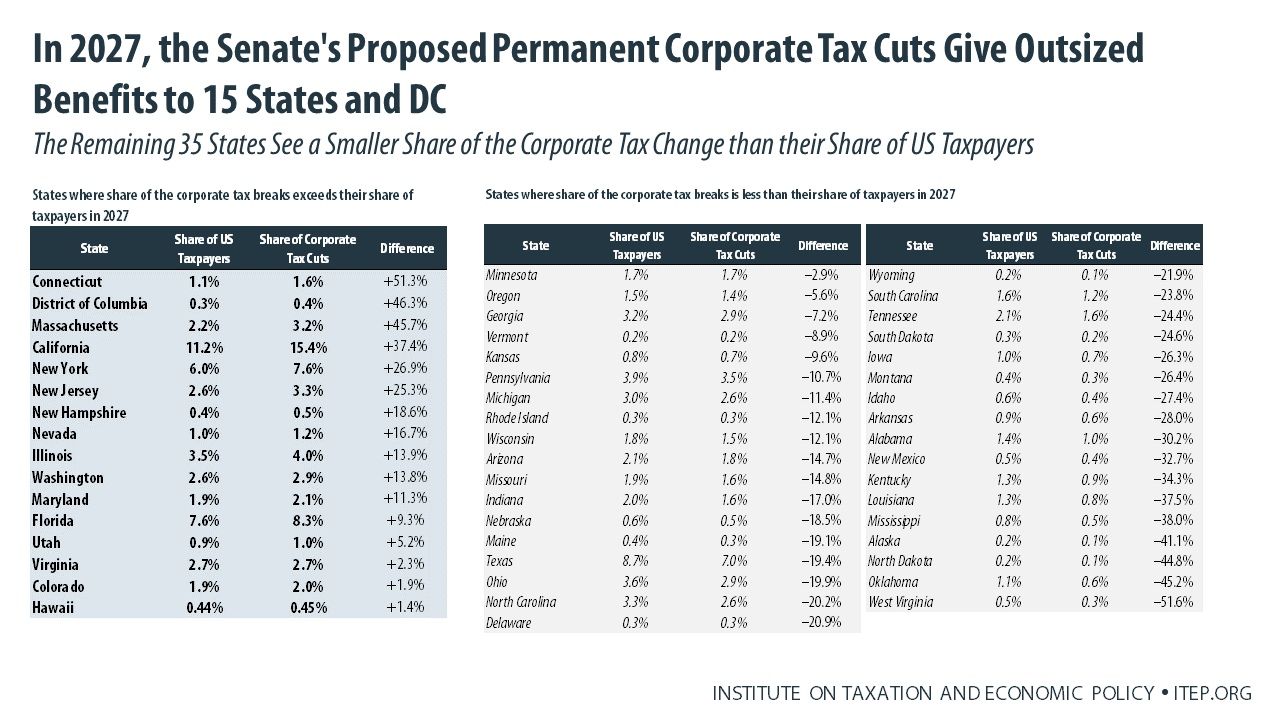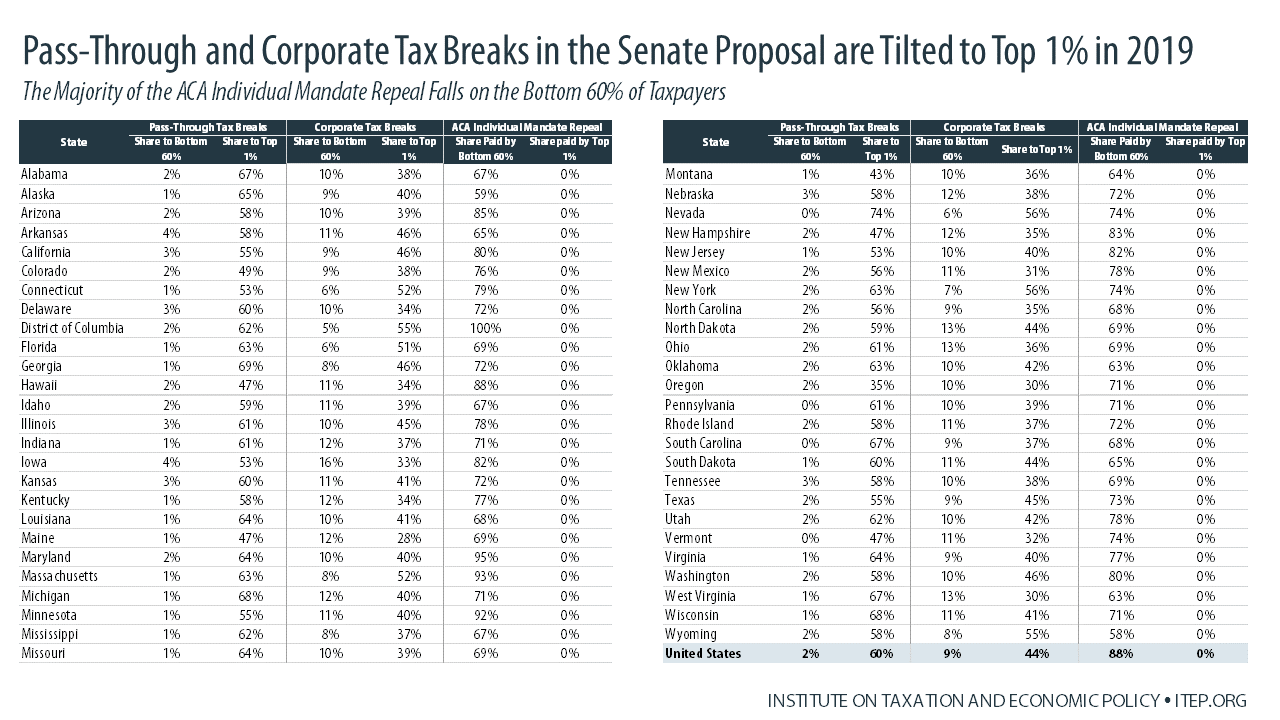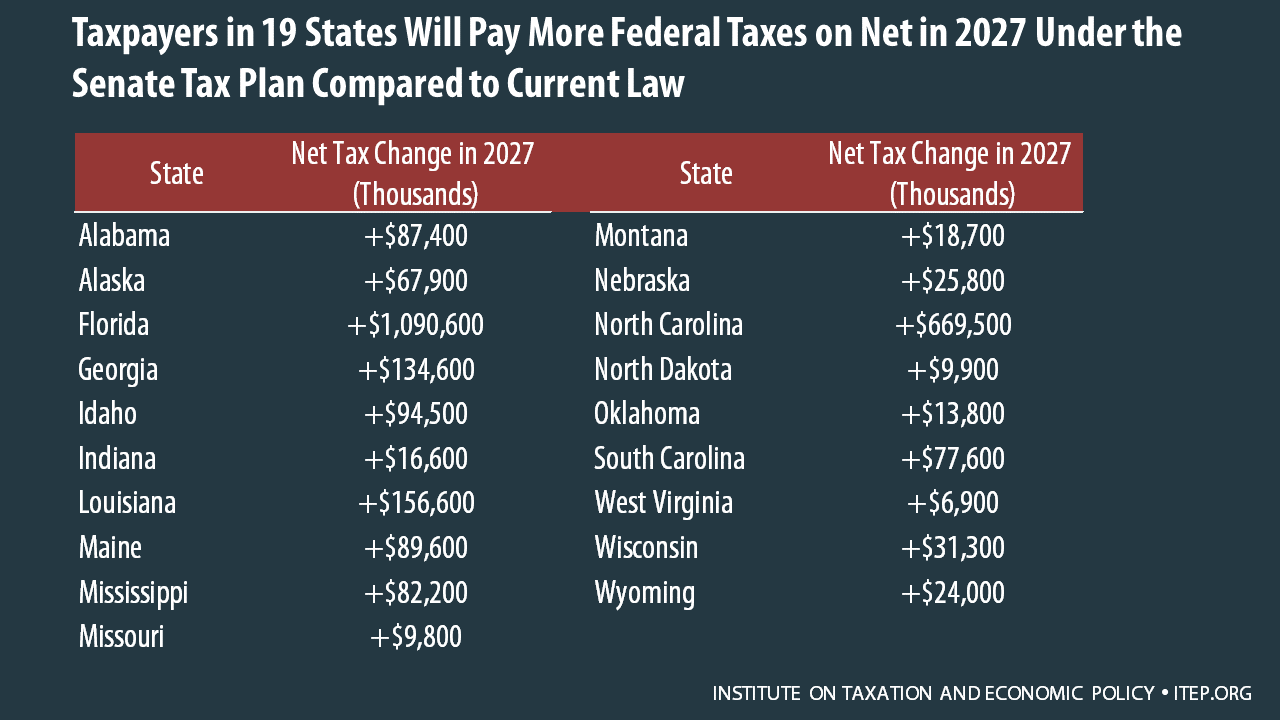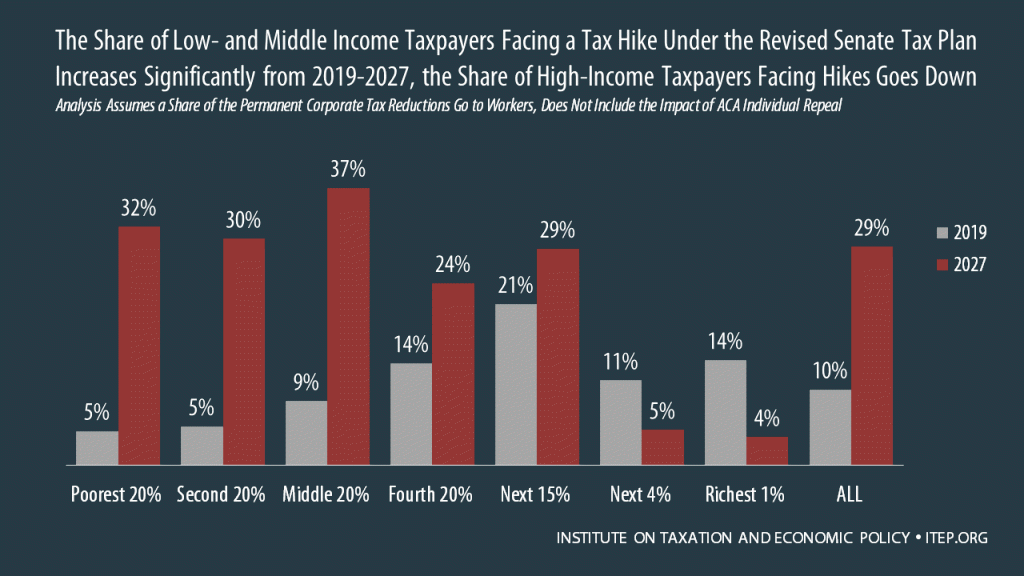Download Detailed National and State-by-State Tables and Graphs
A recent ITEP study concluded that the tax bill before the Senate would raise taxes on at least 29 percent of Americans and cause the populations of 19 states to pay more in federal taxes in 2027 than they do today, while providing foreign investors with more benefits than American households. This report delves deeper by breaking out impacts of different components of the Senate tax plan on U.S. taxpayers in 2019 and 2027. This approach leads to several conclusions:
1- Americans at all income levels would face personal income tax hikes in years after 2025 (including 2027). Excluding corporate tax changes, which have uncertain benefits, federal taxes would rise for all income levels because of the less generous inflation adjustment used for calculating personal income taxes.
2- Even when taking into account all the tax changes (not just changes to the personal income tax), the middle-fifth of taxpayers on the income ladder would face an average tax hike of $60 in 2027.
3- The corporate tax changes would disproportionately benefit 15 states and the District of Columbia, which would receive a share of the corporate tax breaks that exceeds their share of taxpayers in 2027.
4- Pass-through businesses (which do not pay the corporate income tax) would face tax hikes in years after 2025 (including 2027).
5- In 2019 the richest one percent of taxpayers would receive 60 percent of the pass-through tax breaks and 44 percent of the corporate tax breaks.
6- The components of the Senate tax bill would, in combination, result in an overall increase in the federal taxes paid by the residents of 19 states.
——
1) Americans at all income levels would face personal income tax hikes in years after 2025 (including 2027)
The Senate plan’s changes for families and individuals would all be temporary except for the change to a less generous inflation adjustment called the chained consumer price index (chained CPI). Chained CPI would gradually push taxpayers into higher income tax brackets and make the standard deduction, the Earned Income Tax Credit, and several other breaks less generous over time. This change would, on its own, increase taxes on all income groups in years after 2025 (including 2027).
In 2027, households in most income groups would see a net tax cut only if they benefit from the corporate income tax cuts. The richest taxpayers are most likely to benefit from the corporate tax cuts because they own most corporate stocks. This analysis follows the approach of Congress’s official revenue estimator in assuming that some corporate stocks are owned by Americans at all income levels (even though most is owned by the rich) and assuming that a fourth of the benefits of a corporate tax cut will flow to workers by the end of the decade. But as several economists have pointed out, the benefits of corporate tax cuts to workers are highly theoretical and may never materialize.
2) Even when taking into account all tax changes (not just changes to the personal income tax), the middle-fifth of taxpayers would face an average tax hike of $60 in 2027
The graph to the below illustrates the average impact of the Senate bill on Americans in the middle-fifth of the income distribution. The different components of the Senate bill would collectively cut federal taxes for this group by an average of $730 in 2019 but hike their taxes in 2027 by an average of $60.
The personal income tax changes for families and individuals would provide an average tax cut of $640 for this group in 2019 but would impose an average tax hike in 2027 of $110. This would occur because the only tax change for families and individuals still in effect in 2027 would be the less generous inflation adjustment based on chained CPI.
The changes for pass-through businesses would also swing from tax cuts to tax hikes, but these would not be significant for the middle-fifth of Americans.
Because this analysis assumes some middle-income Americans own some corporate stock and assumes and that corporate tax cuts will partly benefit workers in the long-run, this group is estimated to receive an average benefit of $100 from corporate tax cuts in 2019, increasing to $140 in 2027. (However, ITEP’s previous report demonstrated that foreign investors would receive more benefits from the corporate tax cuts than the American middle-class.)
As explained in the methodology section of ITEP’s previous report, this may overstate the benefits of corporate tax cuts to middle-income taxpayers, who would not benefit at all in the short-run unless they own corporate stocks. The increased benefits to the middle-class in the long-run depend on the benefits trickling down to workers in the form of increased wages, which is a highly uncertain prospect.
The estate tax cut in the Senate bill would not benefit the middle-class at all. The Senate bill would increase the minimum estate value that is exempt from the estate tax from about $5.5 million for singles to $11 million (and from $11 million for married couples to $22 million). This analysis assumes that this would only benefit those who are among the richest one percent of taxpayers.
Repeal of the health insurance mandate would cause taxes to rise for some middle-class people because they would no longer receive tax credits to pay health insurance premiums under the Affordable Care Act. Some people would receive tax cuts because the penalty for not obtaining health insurance would be eliminated, but this tax cut would be more than offset by the tax hike that would result from the reduction in premium tax credits. (This is explained in more detail in the methodology section of ITEP’s previous report.)
3) The corporate tax changes would disproportionately benefit 15 states and the District of Columbia, which would receive a share of the corporate tax breaks that exceeds their share of taxpayers in 2027
The tables below list the states that would receive more than their share (based on tax returns) of the corporate tax cuts under the Senate bill in 2027, followed by those receiving less than their share. As explained in detail in the methodology section of ITEP’s previous report, this analysis follows the approach used by other mainstream estimators of assuming that corporate tax cuts benefit corporate shareholders initially and assuming that in the long-run (by 2027 in this case), one-fourth of the benefits go to workers while the rest go to corporate shareholders. Even in this very optimistic scenario, wealthy states are much more likely to benefit than others.
4) Pass-through businesses (which do not pay the corporate income tax), would face tax hikes in years after 2025 (including 2027)
The most significant provisions in the Senate bill that affect pass-through businesses are the 17.4 deduction for certain pass-through business income and the new limits on losses claimed by pass-throughs. The deduction would provide a massive tax break while the loss limitation would raise revenue, but not nearly enough to offset the cost of the deduction. These provisions would expire after 2025.
On the other hand, several provisions that raise taxes on pass-through businesses would still be in effect in years after 2025 (including 2027). As explained in the methodology section of ITEP’s previous report, there are several provisions to repeal or limit breaks for businesses, both pass-throughs and C corporations (the businesses that pay the corporate income tax).
This analysis shows that in 2019, the temporary tax break for pass-throughs would more than offset the tax hike resulting from these revenue-raising provisions. But in 2027, the revenue-raising provisions would be the only pass-through provisions still in effect, resulting in a tax increase of about $15.8 billion in that year alone.
The permanent revenue-raising provisions would also affect C corporations, but would not even come close to offsetting the corporate tax cuts, which are permanent.
5) In 2019 the richest 1 percent of taxpayers would receive 60 percent of the pass-through tax breaks and 44 percent of the corporate tax breaks
Most other taxpayers, however, would see very little benefit from the pass-through and corporate tax changes. The bottom 60 percent of taxpayers would see only 2 percent of the pass-through breaks and 9 percent of the corporate tax cuts.
6) The components of the Senate tax bill would, in combination, result in an overall increase in the federal taxes paid by the residents of 19 states
The state-by-state tables in the appendix illustrate the total dollar impact and the average tax change resulting for each income group in each state. In 19 of those states, the components of the Senate tax bill taken altogether would result in an overall increase in federal taxes in 2027.
Of course, even in these states, some taxpayers would experience tax cuts while others would experience a tax hike or no change at all. But the net result would be that overall, the residents in these 19 states would send more money to the federal government in 2027 than they would under current law.
Components of Senate Tax Plan Included in Analysis
For a more detailed methodology, visit ITEP’s November 18, 2017 report, “Revised Senate Plan Would Raise Taxes on at Least 29% of Americans and Cause 19 States to Pay More Overall.”

